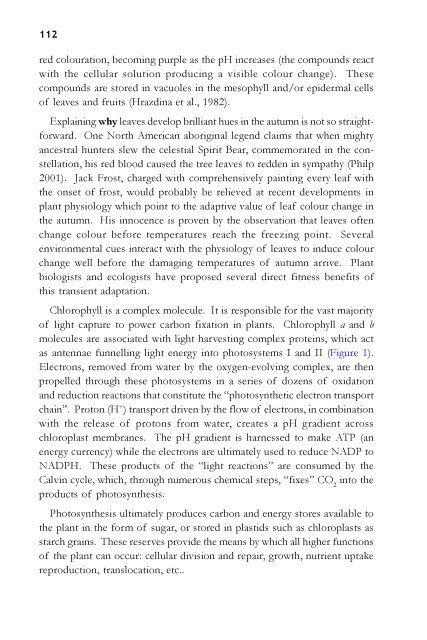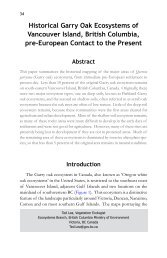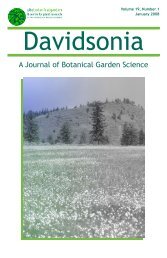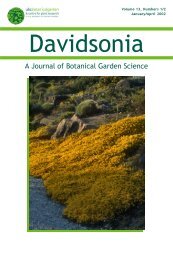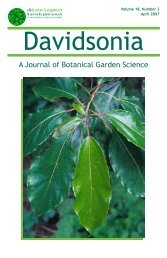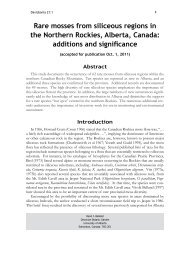pdf wkg Dav.14-14 - Davidsonia
pdf wkg Dav.14-14 - Davidsonia
pdf wkg Dav.14-14 - Davidsonia
Create successful ePaper yourself
Turn your PDF publications into a flip-book with our unique Google optimized e-Paper software.
112<br />
red colouration, becoming purple as the pH increases (the compounds react<br />
with the cellular solution producing a visible colour change). These<br />
compounds are stored in vacuoles in the mesophyll and/or epidermal cells<br />
of leaves and fruits (Hrazdina et al., 1982).<br />
Explaining why leaves develop brilliant hues in the autumn is not so straightforward.<br />
One North American aboriginal legend claims that when mighty<br />
ancestral hunters slew the celestial Spirit Bear, commemorated in the constellation,<br />
his red blood caused the tree leaves to redden in sympathy (Philp<br />
2001). Jack Frost, charged with comprehensively painting every leaf with<br />
the onset of frost, would probably be relieved at recent developments in<br />
plant physiology which point to the adaptive value of leaf colour change in<br />
the autumn. His innocence is proven by the observation that leaves often<br />
change colour before temperatures reach the freezing point. Several<br />
environmental cues interact with the physiology of leaves to induce colour<br />
change well before the damaging temperatures of autumn arrive. Plant<br />
biologists and ecologists have proposed several direct fitness benefits of<br />
this transient adaptation.<br />
Chlorophyll is a complex molecule. It is responsible for the vast majority<br />
of light capture to power carbon fixation in plants. Chlorophyll a and b<br />
molecules are associated with light harvesting complex proteins, which act<br />
as antennae funnelling light energy into photosystems I and II (Figure 1).<br />
Electrons, removed from water by the oxygen-evolving complex, are then<br />
propelled through these photosystems in a series of dozens of oxidation<br />
and reduction reactions that constitute the “photosynthetic electron transport<br />
chain”. Proton (H + ) transport driven by the flow of electrons, in combination<br />
with the release of protons from water, creates a pH gradient across<br />
chloroplast membranes. The pH gradient is harnessed to make ATP (an<br />
energy currency) while the electrons are ultimately used to reduce NADP to<br />
NADPH. These products of the “light reactions” are consumed by the<br />
Calvin cycle, which, through numerous chemical steps, “fixes” CO 2<br />
into the<br />
products of photosynthesis.<br />
Photosynthesis ultimately produces carbon and energy stores available to<br />
the plant in the form of sugar, or stored in plastids such as chloroplasts as<br />
starch grains. These reserves provide the means by which all higher functions<br />
of the plant can occur: cellular division and repair, growth, nutrient uptake<br />
reproduction, translocation, etc..


